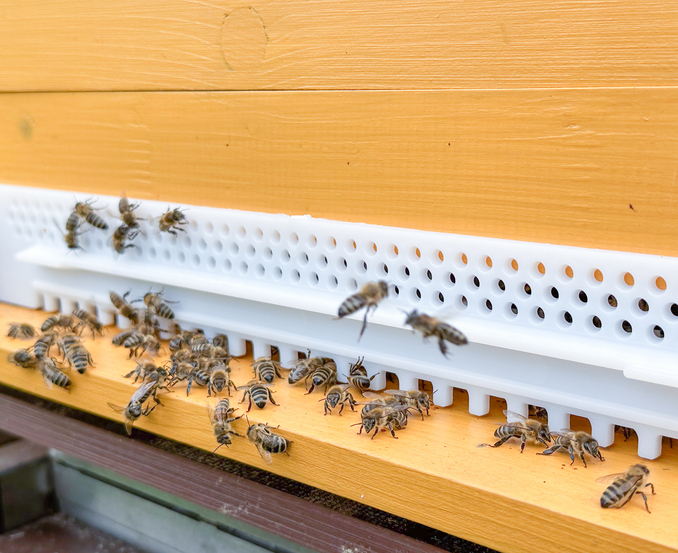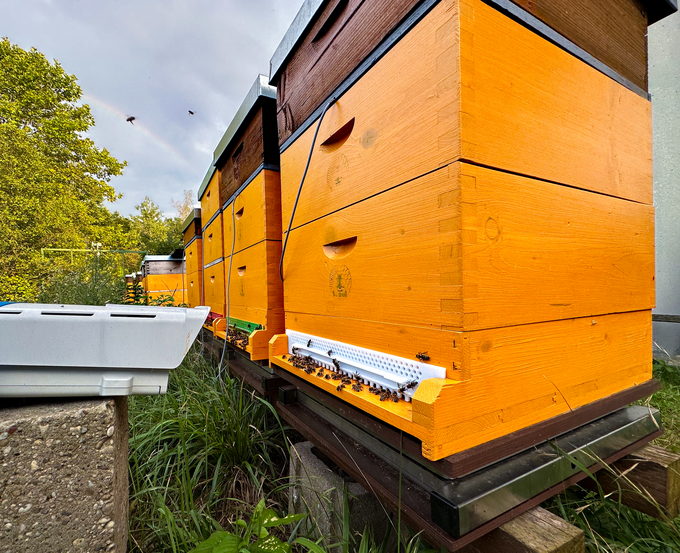In our livestream you can follow what is happening at the flight hole of our hive around the clock. Depending on the time of day, season and current weather, you can make various observations: for example, honey bees flying in and out, some with differently colored pollen packets on their legs, bees fanning the air, controlling guard bees or drones (male bees).
We additionally record measurement data from the bee colony, such as the temperature in the colony (orange line), the change in weight of the hive (green line) and the outside temperature (red line). These data give us information about various events in and around the bee colony.
Here you can see the data of the hive, which you can observe via the livestream. This is located at our site in Vienna Donaustadt.
Temperatures
The temperature in the colony is around 35 °C in summer and drops by 5 to 10 °C in winter. The right temperature is important for bee health and healthy development of bee offspring.
Bees behave differently depending on the weather conditions and outside temperatures. In hot weather, for example, the bees cool the hive. For this purpose, the collecting bees fetch water, which is distributed in the hive by the hive bees. The larvae are protected from dehydration by the moisture. Evaporation of the water leads to cooling of the air. Another possibility is fanning. In this process, the workers gather at the entrance of the nest and actively fan the warm air out of the hive. Fanning with the wings also creates a cooling air flow - the bees act as a fan.
If these possibilities are not sufficient to lower the temperature in the hive sufficiently, a so-called beard forms. In this process, the bees, which are not needed for either water evaporation or fanning, leave the hive and form a cluster in front of the entrance. This prevents them from further raising the temperature inside the hive with their body heat.
In winter, the bees form a winter cluster. In its center sits the queen bee. There, the temperature is warmed up to 25 to 30 °C. To do this, the honey bees arrange themselves tightly packed together to form a ball. The peripheral areas are significantly cooler. The bees therefore regularly change their position from the outside to the inside. The bees sitting on the outside use their flight muscles and trembling movements to ensure that the cluster and the hive do not cool down. If temperatures rise above 10 °C on winter days, the bees can leave the hive to empty their fecal bladder. This keeps the hive clean and prevents the transmission of diseases through the feces.
What does the weight tell us?
In the peak season in early summer, there are up to 50,000 honey bees in one hive. One bee weighs 0.1 g, which means that a colony with 50,000 bees weighs about 5 kg. During the bee year there are constant changes in weight: The weight increases due to incoming bees, nectar, pollen and water input or foreign influences such as rain or snow. The weight decreases due to departing bees, food consumption, evaporation or bees that have died outside the colony. Due to the flight activity of bees, the following pattern is often seen in spring and summer: in the morning, the hive becomes lighter because thousands of bees fly out to forage for food. If an abundant supply of food is available, the weight gradually increases during the day. Then, in the evening, the hive is heaviest: the bees have all returned to the colony.
Last updated: 26.11.2025
automatically translated

